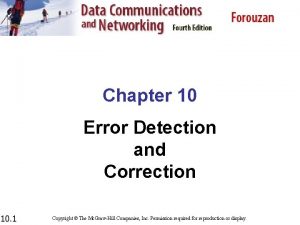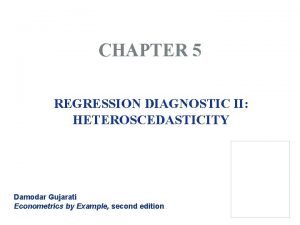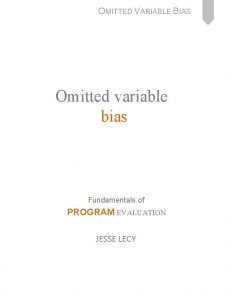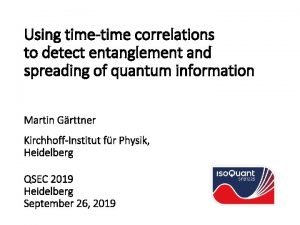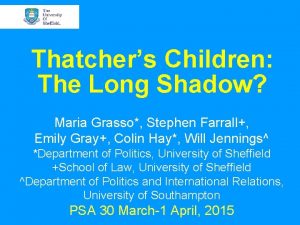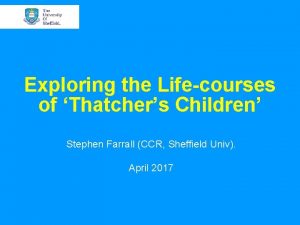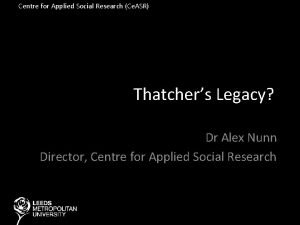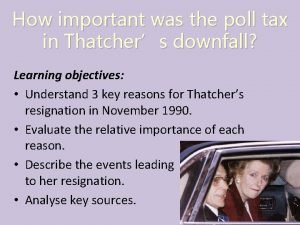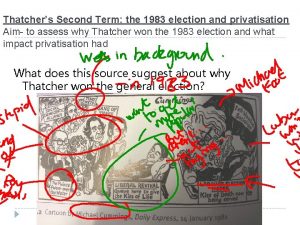Can we detect Thatchers Children in data on











- Slides: 11

Can we detect ‘Thatcher’s Children’ in data on attitudes to crime? Emily Gray*, Maria Grasso* Stephen Farrall*, Will Jennings† and Colin Hay * *University of Sheffield †University of Southampton

Introduction Crime became a key issue in UK political and social agendas in three ways: 1: long-term social and economic trends led to increases in crime rates from the 1960 s. 2: the economic and social policies (neo-liberalism) pursued from the 1970 s/80 s accentuated these trajectories, adding to rises in crime. 3: competition between political parties on the issue of crime raised the profile of crime as an issue and added to levels of public concern over crime. 4: feed-back loops between these operated to foster those circumstances which produced crime and in turn led to the rise of crime as an object of political concern (neoconservatism).

Figure 1. Property crime per capita (Home Office Recorded Statistics and BCS)

Figure 2: % ‘Worried about crime’ – BCS 1982 -2004

Theoretical and substantive contexts • Other authors have sought highlighted the links between crime and political/ cultural shifts (Garland, 2001, Young, 1999). However: • Both cite ‘post modernity’, ‘late modernity’ as driving factors – no political dimension. • Ignore specific Government policies. • Focus on experiences of the middle class.

Age, Period, Cohort Analysis • Longitudinal analysis of BCS/ CSEW data (1982 -2012) affords an APC analysis (Ryder, 1965). • Exploration of the unique contributions of three types of time-related variations - ‘age, period, and cohort’ effects. • Age effects - changes in the life course; period effects arise via specific cultural and economic changes; cohort effects are the core of social change and represent the effects of formative experiences (Ryder 1965). • Ipsos Mori : ‘Generation Y’ / ‘millennials’

Table 1. Political Generations Cohorts (1) Pre. Welfare State Generation (2) Post-War (3) Crumbling Consensus Generation (4) Thatcher’s Children (5) New Labour’s Children Era/period 1903 -1944 1945 -1963 1964 -1978 1979 -1996 1997 -2010 Years of birth 1888 -1929 1930 -1948 1949 -1963 1964 -1981 1982 -1995 N (Tot. 598, 426) 74, 797 166, 009 149, 680 163, 499 44, 441

Thatcher’s children? BCS/ CSEW data 1982 -2012 Table 2. BCS indicators for analysis Questionnaire item Original response categories Recode for analysis How safe do you feel walking alone in this area after dark? [feelsafe] 1 2 3 4 Very safe Fairly safe A bit unsafe Very unsafe 1/2= 0 feels safe 3/4= 1 feels unsafe walking after dark Could you tell me how worried you are about. . . ? Having your home broken into and being burgled [wburgl] 1 2 3 4 Very worried Fairly worried Not very worried Not at all worried 1/2= 1 worried about being mugged 3/4= 0 not worried Could you tell me how worried you are about. . . ? Being mugged and robbed [wmugged] 1 2 3 4 Very worried Fairly worried Not very worried Not at all worried 1/2= 1 worried about being mugged 3/4= 0 not worried How common a problem (in this area) are. . . ? Groups of teenagers making a nuisance [teenhang] 1 Very big problem 2 Fairly big problem 3 Not very big problem 4 Not a problem 1/2= 1 teenagers a problem 3/4= 0 not a problem

Table 3. Results from identified APC models Not safe Burglars Mugging Teenagers Post-War Consensus Generation Crumbling Consensus Generation Thatcher’s Children Generation 0. 54*** 1. 51*** 1. 23*** 1. 65*** 0. 45*** 1. 57*** 1. 24*** 1. 99*** 0. 41*** 1. 56*** 1. 20*** 2. 27*** New Labour’s Children Generation 16 -34 years of age (ref. cat. ) 0. 40*** 1. 24*** 1. 39*** 2. 54*** 36 -55 years of age 0. 83*** 0. 97* 0. 91*** 0. 90*** 56 -105 years of age 1. 08*** 0. 95* 1. 09*** 0. 81*** Year of interview 0. 99*** 0. 95* 0. 96*** 0. 98*** N 427, 605 Pre-Welfare State (ref. cat. )

Provisional results summary • The APC models provide evidence for ‘pure’ generational effects. • Evidence of clear political socialisation periods • Pre-welfare state generation least worried about burglary / robbery, but feel the most unsafe after dark. • Thatcher’s children and New Labour’s children (the youngest cohort) are the most concerned about nuisance ‘teenagers’.

Outline of future work 1. Data sets to be made available 2. Training workshop (with UK Data Service) 3. Documentary film 4. Dissemination events and publications 5. Email emily. gray@sheffield. ac. uk 6. Twitter @thatchers_legacy • .
 A simple parity check can detect
A simple parity check can detect Detect golden ticket attack
Detect golden ticket attack How to detect iridium in gold
How to detect iridium in gold How to detect heteroscedasticity
How to detect heteroscedasticity Stack based overflow
Stack based overflow Conclusion of food adulteration project
Conclusion of food adulteration project How to detect heteroscedasticity
How to detect heteroscedasticity Detect protect perfect
Detect protect perfect How to detect omitted variable bias
How to detect omitted variable bias Detect hex color from image
Detect hex color from image Detect font
Detect font Detect bad neighbor vulnerability
Detect bad neighbor vulnerability
